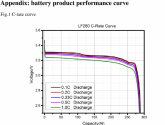DZL, thanks for your effort. First, I left out I was interested only in lithium batteries so Peukert's Law and even heat are not factors I'm considering.
That was the other commenter who brought up Peukert's law, my comment was only meant to apply to lifepo4.
But regarding heat, I don't think you should discount it. From what I've learned here and elsewhere heat is one of the biggest factors effecting lifepo4 lifespan. And C-rate will does effect temperature (less so at low C rates).
Of course ideally it should be up to the user to determine how hard they want to push their batteries, but most people buying drop-in batteries are not going to have the knowledge to make an informed decision, and because drop in manufactures often warranty the batteries for long periods of time, I can understand manufacturers being more conservative. This may be one reason for the trend you noticed
Another reason might be that, there aren't a lot of FET based BMS' above ~120-150A continuous (Daly and ANT being exceptions to this), and those that are available are not small, and usually not cheap. And most of us here don't trust these BMS to handle their stated max current.
I AM aware of the difference between capacity and current and this is where I think battery makers are selling us short. They're selling large capacity batteries with limiting BMS's so that often the C rate is below the Ah rate.
Sorry, I see now that you are aware of the difference but it seems like you may be hung up on the connection between BMS current rating (amps) equaling battery capacity (amp hours) which seems arbitrary to me, beyond equaling 1C--a nice round number. Maybe I'm still misinterpreting what you are concerned with.
That said, its reasonable to want a BMS that can match your batteries max continuous discharge rating. And your concerns below are reasonable:
This means you have to buy 2 or more to power simple things like microwaves. Try finding a 150ah battery that will continuously discharge 150A I've even seen 200ah batteries discharging max 100A. Of course the batteries will last longer at these low C rates but hey, lithium batteries last very long at full C and above rates.
Of course you could just use two 100Ah batteries in parallel to double your max charge/discharge rate or in series to half your amps. Or use raw cells and the BMS of your choice.
I'm still hoping you will give some examples of the batteries that limit you to less than 1C. Its not something I've come across, but I don't pay much attention to drop-ins so that doesn't mean much.
Here is a 200Ah battery that advertises 200A continuous discharge. I don't know anything about it but I think Will has done a video on the Brand before.





